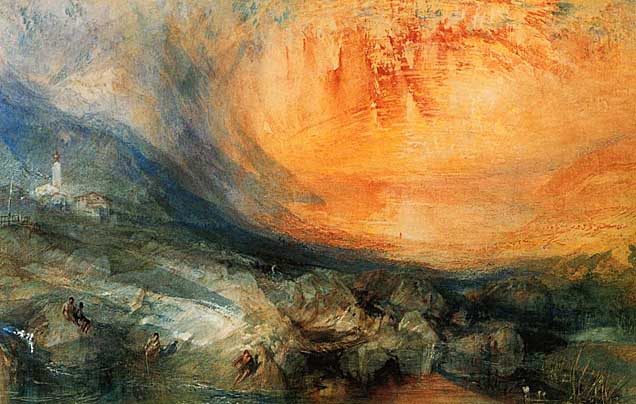18 November 2010
Landslides in Art Part 8: Goldau by JMW Turner
Posted by Dave Petley
One of the greatest of all British artists was Joseph Mallord William (JMW) Turner, often credited as the painter who laid the foundation for Impressionism. Turner, who was born in London in 1775, is best known for his landscape paintings, and in particular those in which he he used light to dramatic effect. He had a particular interest in natural disasters – volcanic eruptions, storms at sea and avalanches were all the subject of paintings during his long and prolific career. It is also interesting to note that there is some evidence that the glorious sunsets that he painted may have been at least in part the result of the 1815 Tambora volcanic eruption in Indonesia.
 Turner frequently travelled to the Alps to paint, and in the 1840s he visited the village of Goldau in Switzerland, which in 1806 had been destroyed by a catastrophic landslide. This slide, which was triggered by heavy rain, had an estimated volume of 120 million cubic metres, covering an area of about 20 square kilometres. The landslide, and the tsunami it created on Lake Lauerz, destroyed 111 houses, 220 farm buildings and two churches, resulting in the deaths of 457 people. The Goldau landslide is very well described by Thuro et al. (2005), and in fact was depicted in the painting to the left, Der Bergsturz von Goldau am 2. Sept. 1806 am Rossberg, Kanton Schwyz, Switzerlandby Gemalde von Keller (sourced from Thuro et al. 2005).
Turner frequently travelled to the Alps to paint, and in the 1840s he visited the village of Goldau in Switzerland, which in 1806 had been destroyed by a catastrophic landslide. This slide, which was triggered by heavy rain, had an estimated volume of 120 million cubic metres, covering an area of about 20 square kilometres. The landslide, and the tsunami it created on Lake Lauerz, destroyed 111 houses, 220 farm buildings and two churches, resulting in the deaths of 457 people. The Goldau landslide is very well described by Thuro et al. (2005), and in fact was depicted in the painting to the left, Der Bergsturz von Goldau am 2. Sept. 1806 am Rossberg, Kanton Schwyz, Switzerlandby Gemalde von Keller (sourced from Thuro et al. 2005).
Turner created a painting of Goldau in 1843 in his characteristic style, blending dramatic use of light with forbidding representation of the landscape to dramatic effect:

The dramatic red sky is widely considered to be symbolic of the destruction of the village. Note also the large boulders, presumably deposited by the landslide, populated by a small group of people (survivors?). The large church surrounded by a small number of houses on the upslope side is also probably symbolic. From a landslide perspective, perhaps the most interesting element is the mass directly behind the church, which appears to have been displaced – there even appears to be a landslide scarp on the left (uphill) side.
Previous editions of landslides in art can be found here:
Reference
Thuro, K., Berner, Ch. and Eberhardt, E. 2005. Der Bergsturz von Goldau 1806 – Versagensmechanismen in wechsellagernden Kongglomeraten und Mergeln. In Moser, M. (ed.) Veroffentlichungen ven der 15. Tagung Ingenieurgeologie, 6-9. April 2005, Erlangen – 482 s., Erlangen (Friederich-Alexander-Universitat), 303-308. (In English!)


 Dave Petley is the Vice-Chancellor of the University of Hull in the United Kingdom. His blog provides commentary and analysis of landslide events occurring worldwide, including the landslides themselves, latest research, and conferences and meetings.
Dave Petley is the Vice-Chancellor of the University of Hull in the United Kingdom. His blog provides commentary and analysis of landslide events occurring worldwide, including the landslides themselves, latest research, and conferences and meetings.
[…] Part 8 […]
Excellent Blog! Landscape paintings wow, I love art and i like the second one most also second part moreover I am unable to open first part it’s showing error. Great stuff + inspirational. Keep going! Thanks for the share!
[…] painting depicts of the aftermath of the so-called Goldau Landslide in Switzerland, which has featured in this series previously thanks to a painting by Joseph Mallord William (JMW) Turner. As I noted then, the Goldau landslide was triggered by heavy rain, with an estimated volume of […]